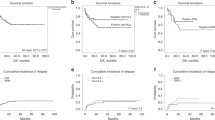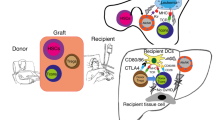Abstract
To study sensitisation to minor histocompatibility antigens (mHag) before and after BMT, we measured anti-donor CTL activity in five patients who had rejected their graft, and in a control group of 10 leukemic patients who engrafted without complications. All patients were transplanted with marrow from an HLA-identical sibling. Fourteen patients were conditioned with cyclophosphamide (120 mg/kg) and TBI (1350 cGy) and received a T cell-depleted graft, while one patient with aplastic anaemia received cyclophosphamide alone and unmanipulated marrow. Before transplantation, anti-donor CTL activity was detected in two of the 15 patients. These patients rejected their grafts at days 21 and 58, respectively. In the other three patients who rejected their grafts at days 41, 60 and 250, CTL activity was found only after transplantation. In contrast, no anti-donor CTLs could be detected at any time in the 10 patients who engrafted permanently. We have identified some of the mHags recognised during graft rejection by cloning and subsequent specificity analysis of the recipient CTLs. In the patient who rejected at day 41 without detectable immunisation before BMT, the response was directed against HA-1, a minor antigen known to play a role in GVHD. In the other combinations, a significant part of the CTL activity was directed against the male antigen H-Y. In the patient who rejected the marrow of her HLA-identical brother at day 250, two clones recognised H-Y, while five others recognised at least three distinct autosomal mHags. This patient had an HLA-identical sister who expressed only one autosomal mHag that had been recognised by one single T cell clone. After re-transplantation with the marrow of this second donor, the CTL activity could no longer be detected and the patient engrafted without further complications.
This is a preview of subscription content, access via your institution
Access options
Subscribe to this journal
Receive 12 print issues and online access
$259.00 per year
only $21.58 per issue
Buy this article
- Purchase on Springer Link
- Instant access to full article PDF
Prices may be subject to local taxes which are calculated during checkout
Similar content being viewed by others
Author information
Authors and Affiliations
Rights and permissions
About this article
Cite this article
Rufer, N., Starobinski, M., Chapuis, B. et al. Clinical consequences of sensitisation to minor histocompatibility antigens before allogeneic bone marrow transplantation. Bone Marrow Transplant 22, 895–898 (1998). https://doi.org/10.1038/sj.bmt.1701466
Received:
Accepted:
Published:
Issue Date:
DOI: https://doi.org/10.1038/sj.bmt.1701466



